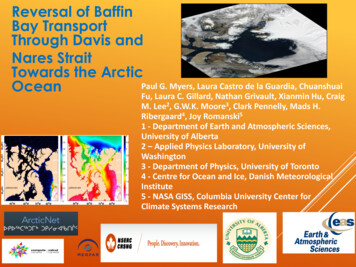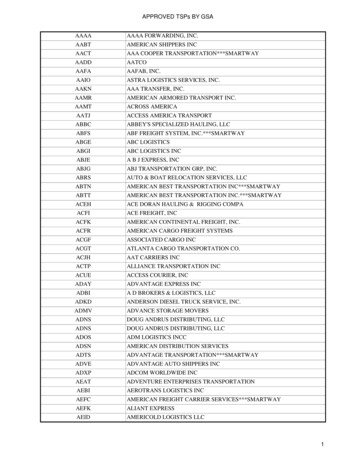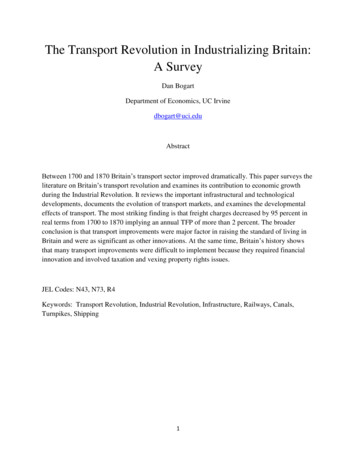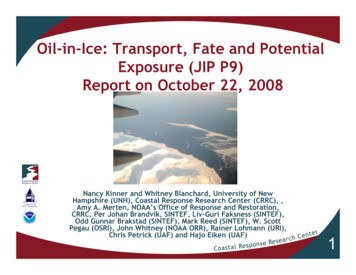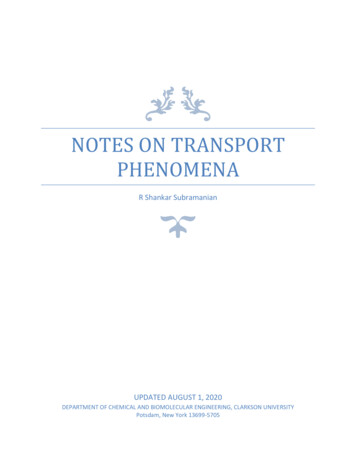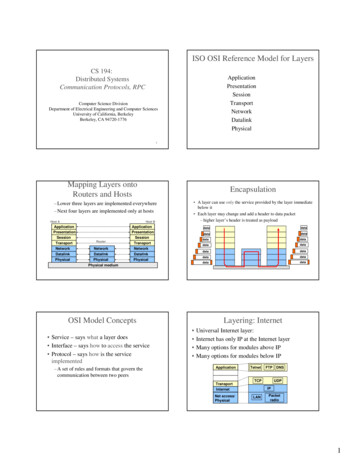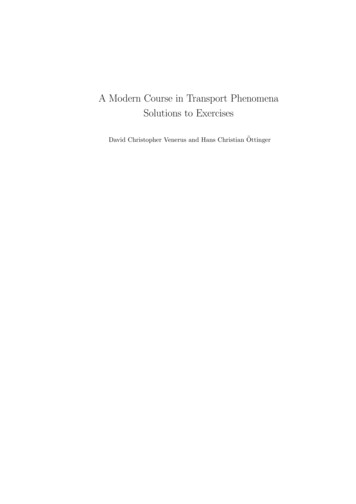
Transcription
A Modern Course in Transport PhenomenaSolutions to ExercisesDavid Christopher Venerus and Hans Christian Öttinger
Solutions to exercisesExercise 1.1The standard barrel of crude oil is 42 US gallons, that is, 42 3.785 litres 0.159 m3 . The 100 000 m3 of crude oil pumped through the Trans-AlaskaPipeline per day given in Section 1.1 hence correspond to 630 000 barrels.With a current price of some 50 US dollars per barrel (mid 2016), the valueof the crude oil transported through the Trans-Alaska Pipeline in a day isgiven by the impressive number of 31 000 000 US dollars.Exercise 2.1Straightforward differentiations of the probability density pαt Θt (x) definedin (2.16) give the following results:"# Θ̇tΘ̇α̇ttpα Θ (x) (x αt ) pαt Θt (x) ,(x αt )2 t t tΘt2Θt2Θ2t [A0 (t) A1 (t)x]pαt Θt (x) x A1 (t)αt A0 (t)A1 (t)2(x αt ) (x αt ) A1 (t) pαt Θt (x) ,ΘtΘtand 1 2D0 (t) 2D(t)p(x) (x α) Θpαt Θt (x) .tt0αΘtt2 x22Θ2tBy comparing the prefactors of (x αt )2 , x αt , and 1, we recover theevolution equations (2.9) and (2.10).
Solutions to Exercises3Exercise 2.2According to the superposition principle, we haveZ1/2Z1/2Zp0 t (x y)dy py t (x)dy 1/2 1x 1/2x 1/2 erf erf.22t2tp(t, x) 1/2 (x 1/2)/ 2t (x 1/2)/ 2tp0 1/2 (z)dzExercise 2.3In Mathematica:convol[x ,sig ] t,0,1}] Integrate[(1 {Piecewise[{{1 x,-1 x 0},{1-x,0 x -2,2},PlotRange- {0,1},AxesLabel- {Text[Style[x,FontSize- 20]],Text[Style[p[t,x],FontSize- 20]]}] Notice that Mathematicaactually gives an analytical result for the integral implied by the superposition principle in terms of error functions. Theresulting curves are shown in Figure C.9.pHt, xL1.00.80.60.40.2-2-1Figure C.9 Mathematica2.3.012x output for the diffusion problem of ExerciseExercise 2.4 Z Z d p p p ln(p/peq ) dx ln(p/peq ) dxdt t t
4A Modern Course in Transport PhenomenaZ Jln(p/peq )dx xZJ ln(p/peq ) dx , xwhere the normalization of p and the diffusion equation have been used. Byinserting the expression for J given in (2.25) we obtain the desired result.Exercise 2.5The eigenvalue problem for pure diffusion with D 1 is given by λp(x) 1 d2 p(x),2 dx2which has the solutions p(x) C1 sin( 2λ x C2 ) .The boundary condition p(0) 0 suggest C2 0 and the boundary condition p(1) 0 then selects discrete values of λ,n2 π 2.2We can now write the solution as the Fourier seriesp2λn nπ ,p(t, x) Xλn cn sin(nπx) e λn t ,n 1where the coefficients cn are determined by the initial condition at t 0.By multiplying with sin(mπx) and integrating, we findZ 1Z 1 Xsin(mπx) dx cnsin(mπx) sin(nπx) dx ,0n 10leading to the explicit expressions1cm[1 ( 1)m ] .mπ2Note that all the coefficients cn with even n vanish. The fraction of thesubstance released as a function of time is given byZ 1X81 p(t, x) dx 1 e λn t .22nπ0n oddExercise 2.6According to the respective definitions, we haveT exp{M (t1 ) M (t2 )} 1 M (t1 ) M (t2 )
Solutions to Exercises51 [M (t1 )2 M (t2 )2 ] M (t2 ) · M (t1 )211 [M (t1 )3 M (t2 )3 ] [M (t2 ) · M (t1 )2 M (t2 )2 · M (t1 )] . . . ,62andexp{M (t1 ) M (t2 )} 1 M (t1 ) M (t2 )11 [M (t1 ) M (t2 )]2 [M (t1 ) M (t2 )]3 . . . .26In terms of the commutator C M (t2 ) · M (t1 ) M (t1 ) · M (t2 ), thedifference can be written as1T exp{M (t1 ) M (t2 )} exp{M (t1 ) M (t2 )} C21 [C · M (t1 ) M (t2 ) · C M (t2 ) · M (t1 )2 M (t1 )2 · M (t2 )6 M (t2 )2 · M (t1 ) M (t1 ) · M (t2 )2 ] . . . .Exercise 2.7Straightforward differentiations of the probability density pαt Θt (x) definedin (2.39) give the following results: 1 1pαt Θt (x) (x αt ) · Θ 1t · Θ̇t · Θt · (x αt ) t2 1 1 1pαt Θt (x) , (x αt ) · Θt · α̇t tr Θ̇t · Θt2 · [A0 (t) A1 (t) · x] pαt Θt (x) x 1 1T(x αt ) · (Θ 1t A1 (t) A1 (t) · Θt ) · (x αt )2 1 (x αt ) · Θt · (A0 (t) A1 (t) · αt ) trA1 (t) pαt Θt (x) ,and1 1h 1: D0 (t) pαt Θt (x) (x αt ) · Θ 1t · D0 (t) · Θt · (x αt )2 x x2 i tr D0 (t) · Θ 1pαt Θt (x) .tBy comparing prefactors, we obtain the following evolution equations:α̇t A1 (t) · αt A0 (t) ,
6A Modern Course in Transport PhenomenaandΘ̇t A1 (t) · Θt Θt · AT1 (t) D0 (t) .Exercise 2.8In Mathematica :Theta {{0.4,0.3},{0.3,0.6}}invT Inverse[Theta]f[x1 ,x2 ]: Exp[-1/2 {x1,x2}.invT.{x1,x2}]/Sqrt[(2 Pi)ˆ2 Det[Theta]]Plot3D[f[x1,x2],{x1,-2,2},{x2,-2,2}]The output is shown in Figure C.10.Figure C.10 MathematicaExercise 2.8. output for the two-dimensional Gaussian ofExercise 2.9The covariance matrix Θ is symmetric and can hence be diagonalized. Bya linear transformation to suitable coordinates, Θ can hence be assumed tobe diagonal. For diagonal Θ, the probability density in (2.39) indeed is theproduct of d one-dimensional Gaussians.Exercise 3.1To switch from a rectangular to a triangular initial distribution, we onlyneed to change the stochastic initial condition. The curve for t 0.03 isproduced by the following MATLABcode: % Simulation parameters
Solutions to Exercises7NTRA 1000;NTIME 3;NHIST 100;DT 0.01;XMIN -1.;DX 0.05;XMAX 1.;edges XMIN:DX:XMAX;centers XMIN DX/2:DX:XMAX-DX/2;for K 1:NHIST% Generation of NTRA trajectories xy random('Uniform',-1,1,[1,NTRA]); x sign(y).*(1-sqrt(abs(y)));for J 1:NTIMEx x random('Normal',0,sqrt(DT),[1,NTRA]);end% Collection of NHIST histograms in matrix pp(K,:) histc(x,edges)/(DX*NTRA);end% Plot of simulation resultserrorbar([centers )Exercise 3.2By integrating (3.19) over x, we obtain Z Z Z t1 (x t t0 )2a(t0 )pexp dt0 dx .1 pf (t, x) dx 2t t02π(t t0 )000For the time derivative of the left-hand side of this equation, we obtain bymeans of the diffusion equationZ1 pf (t, x)d pf (t, x) pf (t, 0) .dt 02 xx 0The contribution to the time derivative of the right-hand side of the aboveequation resulting from the upper limit of the time integration is Z 11 (x )21a(t) lim exp dx a(t) , 02 22π 0 where we can neglect the mean value compared to the width of theGaussian distribution. For the time derivative of the Gaussian under theintegral in the above equation, we can again use the diffusion equation toobtain Z Z ta(t0 ) 1 21 (x t t0 )2p exp dt0 dx 200 x2 x2t t2π(t t )00Z1 ta(t0 )0p e (t t )/2 dt0 .02 02π(t t )By equating the time derivatives of the left- and right-hand sides, we arriveat the desired result (3.20).
8A Modern Course in Transport Phenomena Exercise 3.3Mathematicacode for the inverse Laplace transform using the Zakianmethod, adapted from the implementation Zakian.nb by Housam Binousin the Wolfram Library Archive (library.wolfram.com):alph {12.83767675 I 1.666063445,12.22613209 I 5.012718792,10.9343031 I 8.40967312,8.77643472 I 11.9218539,5.22545336 I 15.7295290};K {-36902.0821 I 196990.426,61277.0252-I 95408.6255,-28916.5629 I 18169.1853,4655.36114-I 1.90152864,-118.741401-I 141.303691};abar[s ] Exp[1-Sqrt[1 2s]]*(Sqrt[1 2s] 1)/(Sqrt[1 2s]-1);a[t ] 2/t t,0,5},PlotRange- {0,2.5}]Mathematica code for the evaluation of (3.19):p[t ,x ]: (1/Sqrt[2Pi t]) Exp[-0.5(x-1 t)ˆ2/t] NIntegrate[(a[tp]/Sqrt[2Pi(t-tp)]) Exp[-0.5(x ercise 4.1From (4.15) and (4.21) we have S 13N R̃ T U V,N2Uwhich gives (4.22a). Similarly, from (4.16) and (4.21) we have S pN R̃ T V U,NVwhich gives (4.22b). Finally, from (4.17) and (4.21) we have for a singlecomponent fluid S h U 3/2 V i 5µ̃ s̃0 R̃ ln R̃T N U,VN ũ0N ṽ02Rearranging and using previous results, we can writeµ̃ T s̃0 R̃T lnwhere we have used ũ0 µ̃0 (T ) leads to (4.22c).32 R̃T0 .h T 3/2 R̃T iT0pṽ05 R̃T2Collecting all terms depending on T in
Solutions to Exercises9Exercise 4.2We first invert (4.21) to obtainU (S, V, N ) N ũ0n 2 S N s̃ o V 2/30expN ṽ03 N R̃as a starting point for our Legendre transformation. By differentiation withrespect to S we obtainn 2 S N s̃ o2ũ0 V 2/30exp,T (S, V, N ) Nṽ33R̃N R̃0and by inversionh V 3R̃T 3/2 iS(T, V, N ) N s̃0 N R̃ ln.N ṽ0 2ũ0Now, from (4.24) the Helmholtz free energy is then given by F (T, V, N ) U (S(T, V, N ), V, N ) T S(T, V, N ),h V 3R̃T 3/2 i3F (T, V, N ) N R̃T N s̃0 T N R̃T ln2N ṽ0 2ũ0h V 3R̃T 3/2n s̃ oi0 N R̃T lnexp.N ṽ0 2ũ0 eR̃This expression can be simplified considerably by introducing a new constantc in terms of all the other constants,n s̃ o1 3R̃ 3/20c exp.ṽ0 2ũ0 eR̃Exercise 4.3By integrating p N R̃T /V we findhF (T, V, N ) N R̃T lniV,C(T, N )where C(T, N ) represents an additive integration constant. To obtain anextensive free energy, C(T, N ) must be of the form C(T, N ) N C̃(T ).Equation (4.25) then leads to the entropy V1 dC̃(T )S(T, V, N ) N R̃ ln N R̃T.N C̃(T )C̃(T ) dTFor reproducing the ideal-gas entropy (see solution to Exercise 4.2) we needto choose1 c T 3/2 ,C̃(T )
10A Modern Course in Transport Phenomenawhere c plays the role of a further integration constant. For a suitable matching of constants, the resulting Helmholtz free energy (4.39) coincides withthe solution to Exercise 4.2.Exercise 4.4In terms of intensive quantities we can write (4.15) as 1/T ( s/ u)ρ and(4.17) as µ̂/T ( s/ ρ)u . Applying these to (4.56) we obtain 13 kB ρµ̂s kB ln R0 (ρ) 5. , T2 muTρm ln ρ2Combining these using the Euler equation (4.44) gives the following equations of state: 3 ρkB T ln R0 (ρ)ρkB Tu 1 ,,p 2 mm ln ρwhich match the equations of state for an ideal gas if R0 (ρ) is constant.Exercise 4.5Using the Maxwell relation ( ŝ/ v̂)T,wα ( p/ T )v̂,wα and definition forspecific heat capacity ĉv̂ T ( ŝ/ T )v̂,wα in (4.49) givesh p ih ŝ idû ĉv̂ dT T p dv̂ T (µ̂1 µ̂2 ) dw1 . T v̂,w1 w1 T,v̂Focusing on the last term in square brackets, we use (4.52) and write ŝ T (ŝ1 ŝ2 ) û1 û2 p(v̂1 v̂2 ) (µ̂1 µ̂2 ),T w1 T,pwhich can be arranged to give ŝ T (µ̂1 µ̂2 ) (ĥ1 ĥ2 ). w1 T,pNow, to change the independent variables in the derivative on the left-handside, we write ŝ ŝ ŝ v̂ ŝ p (v̂1 v̂2 ), w1 T,p w1 T,v̂ v̂ T,w1 w1 T,p w1 T,v̂ T v̂,w1where have used the Maxwell relation and (4.52) to obtain the second equality. Combining the last two results, we obtain ŝ p T (µ̂1 µ̂2 ) (ĥ1 ĥ2 ) T(v̂1 v̂2 ). w1 T,v̂ T v̂,w1Substitution in the expression above for dû gives the result in (4.53).
Solutions to Exercises11Now, substituting the total differential of ŝ(T, p, w1 ) in (4.45) givesi ŝ h ŝ ŝ (µ̂1 µ̂2 ) dw1 .dT pdv̂ Tdp Tdû T T p,w1 p T w1 T,pUsing ĉp T ( ŝ/ T )p,wα for the specific heat capacity at constant pressureand composition and the Maxwell relation ( ŝ/ p)T,wα ( v̂/ T )p,wα weobtain v̂ h ŝ idû ĉp dT pdv̂ Tdp T (µ̂1 µ̂2 ) dw1 . T p w1 T,pReplacing the terms inside the square brackets with the result found previously gives the expression in (4.57)Exercise 4.6The total differential of the specific Gibbs free energy for a two-componentsystem ĝ ĝ(T, p, w1 ) can be written asdĝ ŝdT v̂dp (µ̂1 µ̂2 )dw1 ,where ĝ ŝ , T p,w1v̂ ĝ pT,w1,µ̂1 µ̂2 ĝ . w1 T,pSetting â ĝ in (4.52) and comparing with the third expression above, wehave ĝα µ̂α . Now, from (4.51) we can write ĝ1 µ̂1 û1 pv̂1 T ŝ1 sothat the total differential of µ̂1 µ̂1 (T, p, w1 ) can be written as µ̂ 1dµ̂1 ŝ1 dT v̂1 dp dw1 . w1 T,pwhere ŝ1 µ̂1 T ,v̂1 p,w1 µ̂1 p .T,w1Exercise 4.7One way to define an ideal mixture (not necessarily comprised of ideal gascomponents) is by the fundamental equation for the molar Gibbs free energyg̃(T, p, xα ) kXxα g̃α0 (T, p) R̃Tα 1kXxα ln xα .α 1Now, since g̃ ũ pṽ T s̃, we can write using (4.59) the following:T s̃ kXα 1xα g̃α0 R̃TkXα 1xα ln xα kXα 1xα ũ0α pkXα 1xα ṽα0
12A Modern Course in Transport Phenomena TkXα 1kXxα (g̃α0 ũ0α pṽα0 ) R̃TkXxα ln xαα 1xα s̃0α R̃Tα 1kXxα ln xα ,α 1which givess̃(T, p, xα ) kXxα s̃0α (T, p) R̃α 1kXxα ln xα ,α 1where the second term is the entropy of mixing, which is always positive.Now, since g̃ µ̃ and g̃α µ̃α , we write the fundamental equation for idealmixtures as follows:kXα 1xα µ̃α kXxα µ̃0α R̃Tα 1kXα 1xα ln xα kXxα (µ̃0α R̃T ln xα ),α 1which gives (4.60).Exercise 4.8Using (4.62), the chemical potential for a non-ideal gas (I) isIIµ̃Iα µ̃0,igα (T, p) R̃T ln(xα φ̄α p ).Using (4.63) for a liquid (II) that is a nonideal mixture, the chemical potential is0,slsatIIµ̃IIα µ̃α (T, pα ) R̃T ln(xα γ̄α ),satNow, for µ̃0,slα (T, pα ), we can writesat0,ig0 satµ̃0,slα (T, pα ) µ̃α (T, p) R̃T ln(φ̄α pα ),so that0,igII0 satµ̃IIα µ̃α (T, p) R̃T ln(xα γ̄α φ̄α pα ).For a system at equilibrium, setting µ̃Iα µ̃IIα gives (4.64).Exercise 4.9For the case of a gas dissolved at low concentration in a liquid (II), substitution of fα kH,α xα in (4.61) gives0,igIIµ̃IIα µ̃α (T, p) R̃T ln(kH,α xα ).Using the expression for µ̃Iα from Exercise 4.8 and setting µ̃Iα µ̃IIα gives(4.65).
Solutions to Exercises13Exercise 4.10By combining (4.60) and (4.70), we obtainkXα 1k1 Xν̃α ln xα ν̃α µ̃0α (T, p),RTα 1from which we obtain (4.72) by exponentiation. By differentiation we get kX µ̃0α (T, p)02 d.R̃Tln K(T ) ν̃α µ̃α (T, p) TdT Tα 1A Maxwell relation implied by (4.29), together with (see Exercise 4.7)s̃(T, p, xα ) kXxα s̃0α (T, p) R̃α 1kXxα ln xα ,α 1leads to µ̃0α S 0 s̃0α , T Nαso that we obtain (4.73) with h̃0α µ̃0α T s̃0α .Exercise 5.1RFor (i): · u u0 , V · u dV u0 L3 , andZ LZ LZn · u dA dx2dx3 [u1 (x1 L, x2 , x3 ) u1 (x1 0, x2 , x3 )]02A00 L [u0 u L u0 ] u0 L3 .For (ii): · u 3x22 x1 andZ 1ZZZ 2dx3dx2 · u dV 110V2ZZ dx3 110Z2Z 1dx1 (3x22 x1 )dx2 6x22 8.Zn · u dA dx2 [u1 (x1 1, x2 , x3 ) u1 (x1 1, x2 , x3 )]dx3A1 10Z2 Z1dx1 [u2 (x1 , x2 1, x3 ) u2 (x1 , x2 1, x3 )]dx3 1Z 10Z1 dx1 [u3 (x1 , x2 , x3 2) u3 (x1 , x2 , x3 0)]dx2Z 12 2Z 11dx30dx1 8. 1
14A Modern Course in Transport PhenomenaExercise 5.2For constant u: 1 1 · u δr · u δr δφ δθ r r φ r sin φ θ 22u u .r rrZ RZ2ur2 dr · u dV 4π 4πR2 u.rZ 0ZVdA δr · u 4πR2 u.n · u dA AAFor u(r): 2 u(r).r r ZZ R2u(r)02 u (r) · u dV 4πr drrV0Z Rd 4πdr (r2 u(r)) 4πR2 u(R).drZZ 0n · u dA dA δr · u 4πR2 u(R). ·u AA0that from all spherFor u(r) Q/r2 , ·u 2u(r)r u (r) 0, which impliesRical shells the contribution is zero. Nevertheless, A n · u dA 4πR2 u(R) 4πQ. The reason is the singularity at the origin.Exercise 5.3The unit vector t v/v is tangent to a streamline with position r(ζ) sothat t dr(ζ)/dζ. Hence, we can write v t 0, or3Xi,j 1εijk vi xj 0. ζFor v v1 (x1 , x2 )δ1 v2 (x1 , x2 )δ2 the above can, using (5.9), be written as ψ x2 ψ x1 0, x2 ζ x1 ζor ψ ζ 0, which means the stream function ψ is constant along a streamline.Now, for x1 c, an arbitrary constant, we can write dψ(c, x2 ) ψ x2 dx2
Solutions to Exercises15ρv1 dx1 , which after integration gives:Z ψ2 (c,x2 )ψ2 ψ1 ρv1 dx2ψ1 (c,x2 )where ψ1 , ψ2 are values of the stream function on adjacent streamlines.Hence, the mass flow rate (per unit width) between any two streamlines isequal to the difference between the values of the two streamlines.Exercise 5.4Substitution of cα cxα for cα in (5.21) gives x h ciαc v · xα xα · (cv ) · Jα ν̃α Γ̃ t tUsing (5.22) to replace terms in the square bracket gives the result in (5.23).Exercise 5.5We begin with the difference in reference velocities, which can be written asv v kXxβ (v vβ ) β 1kXxββ 1ρβkjβ 1 X jβ,cM̃ββ 1which is the result in (5.24). Note that (5.13) was used for the second equality, and the third equality follows from basic relations between concentration variables: xβ cβ /c ρβ /cM̃β . Next, we combine (5.13) and M̃α times(5.20), which givesM̃α Jα jα jα ρα (v v ) jα kρα X jβ,cM̃ββ 1where we have used (5.24) to get the result in (5.25). For the volume-averagevelocity, we haveρα vα ρα v † jα† .PMultiplication by v̂α and summing we obtain: kα 1 v̂α jα† 0. Since v † Pkα 1 ρα v̂α vα , the difference in reference velocities can be written as†v v kXρα v̂α (v vβ ) β 1kXv̂β jβ ,β 1which is the result in (5.27). Now, using (5.13), we can writejα† jα ρα (v v † ),
16A Modern Course in Transport Phenomenawhich, when combined with (5.27) gives (5.28).In the absence of chemical reaction (Γ 0), we write (5.11) as follows ρα · (v † ρα jα† ). tMultiplication by v̂α and summing, we havekkkα 1α 1α 1XX X(v̂α ρα ) ·(v̂α ρα )v † ·(v̂α jα† ), twhere, since we are considering ideal mixtures, we have taken v̂α to bePPconstant. Now, since kα 1 ρα v̂α 1 and kα 1 v̂α jα† 0, we obtain · v † 0.Exercise 5.6PMultiplying dNα nj 1 ν̃α,j dξj by M̃α , we obtaind(Nα M̃α ) nXM̃α ν̃α,j dξjj 1Summing over α, the left-hand side vanishes so that we can writeM̃q,j kXν̃α,j M̃α α qj 1qjXν̃α,j M̃α .α 1Dividing the first equation by V dt and using ν̃α,j να,j (M̃qj /M̃α ) givesnnnj 1j 1j 1XXd Nα M̃α X1 dξj1 dξj M̃α ν̃α,j να,j M̃q,j να,j Γj ,dtVV dtV dtwhere Γj M̃q,j /V dξj /dt. Dividing (5.29) by M̃α and using (5.20) we obtainnnj 1j 1X ν̃α,jX cα · (vα cα ) Γj · (v cα Jα ) ν̃α,j Γ̃j , tM̃q,jwhere Γ̃j Γj /M̃q,j . Summing over α we obtainknXX c · (v c) ν̃α,j Γ̃j . tα 1 j 1
Solutions to Exercises17Now, setting cα cxα , the last two results can be used to obtainn k x XXαc v · xα · Jα ν̃α,j xαν̃β,j Γ̃j . tj 1β 1Exercise 5.7From the mass balance (5.5) we have with the assumption of constant ρ andvelocity v vδz the following:dv 0,dzwhich implies the velocity is constant along the length of the reactor. Forsteady state, the species mass balance (5.14), neglecting diffusive transport,simplifies todρα0 v να Γ.dzDividing by M̃α making the substitution ν̃α να M̃q /M̃α givesvdcα ν̃α Γ̃,dzwhere Γ̃ Γ/M̃q . Integration from the entrance with cα (0), to the exit withcα (L), of the reactor having length L, gives the desired result.Exercise 5.8To find the vector product of r with (5.32) we write m r · (vm) r · π r ρg. tThe first term on the right-hand side can be written asr r · (vm) 3Xi,j,k,p 1 3X xp δp δi· v j δj m k δk x p δp vj mk δk xi xj3Xj,k,p,m 1 3Xj,k,p,m 1 3Xj,k,p,m 1j,k,p 1εpkm xp vj mk δm xj εpkmxp vj mk δm xj3Xεpkm vj mkj,k,p,m 1 xpδm xj3X vj (εpkm xp mk δm ) εjkm vj mk δm xjj,k,m 1
18A Modern Course in Transport Phenomena · v(r m) v m · v(r m)The second term on the right-hand side can be written as3Xr ( · π) i,j,k,p 13X · πjk δj δk πjk δkx p δp x p δp δi xi xj3X j,k,p 1εpkm xpj,k,p,m 13X j,k,p,m 13X j,k,p,m 13X j,k,p,m 1 πjk δm xj xp πjk δm εpkm xj3Xεpkm πjkj,k,p,m 1 xpδm xj3X Tεpkm xp πkj δm εjkm πjk δm xjj,k,m 13X T Tεmkj πjk δm(εpkj xp πkm ) δm xjj,k,m 1T T · (r π ) ε : πCombining the above results, and recognizing that r is independent of time,gives desired result. For the source term we write3Xε:π i,j,k,p,m 1 3X3Xεijk δi δj δk : πmp δm δp εijk πkj δii,j,k 1(εij1 π1j εij2 π2j εij3 π3j )δii,j 1 ε321 (π12 π21 )δ3 ε231 (π13 π31 )δ2 ε132 (π23 π32 )δ1 ,which vanishes only if πij πji , or the pressure tensor is symmetric π T π.Exercise 5.9To show the velocity gradient v is symmetric, we must find its relation tothe vorticity w. We begin by computing ε · w,ε·w 3Xεijk δi δj δk · wp δp i,j,k,p 1 3Xi,j,k 13Xi,j,k,m,n,p 1εijk δi δj δk · εmnp vnδp xm3X vn vnδi δj εijk εmnk δi δj (δim δjn δin δjm ) xm xmi,j,k 1
Solutions to Exercises 3Xi,j,k 1δi δj vj xi 19 vi v v T xjwhere the second equality in the second line follows from a well knownidentity between the permuation symbol and Kronecker delta. Since w 0for an irrotational flow, the velocity gradient is symmetric.We use the identity a 0, which holds for arbitrary scalar a. Forirrotational flow w v 0, so that can write v Φ, which whensubstituted in (5.36), gives (5.44).Now, for the two-dimensional flow v v1 (x1 , x2 )δ1 v2 (x1 , x2 )δ2 , we canwrite v Φ as follows:v1 Φ, x1v2 Φ. x2Combining these with (5.9) setting ρ 1 gives the following: Φ ψ , x1 x2 Φ ψ , x2 x1known as the Cauchy-Riemann equations. Hence, the stream functionψ(x1 , x2 ) and velocity potential Φ(x1 , x2 ) are orthogonal.Exercise 5.10Using the identity in (5.45), we write the steady-state form of (5.40) asfollows:h1i 1 P ρ v 2 v ( v) ρ v 2 ,22where the second equality follows since v 0. Using (5.41) and rearranging terms taking ρ to be constant gives (5.46).Exercise 5.11Since v Φ, we can writevr Φ, rvθ 1 Φ,r θso that Φ(r, θ) is governed by (5.44), which takes the form1 Φ 1 2Φr 2 2 0.r r rr θFor an impermeable cylinder vr (R, θ) 0, which leads to the boundarycondition Φ/ r(R, θ) 0. Since v( , θ) V δ1 V cos θδr V sin θδθ ,
20A Modern Course in Transport Phenomenawhich leads to the boundary condition Φ( , θ) V r cos θ. Substitution ofΦ f (r) cos θ in the equation above leads to1 d df fr 2 0,r dr drrwhich is solved subject todf(R) 0,f ( ) V r.drWriting f (r) as a power series, we find using the boundary conditions f (r) V R(R/r r/R), so that the velocity potential is Rr .Φ V R cos θrRHence, the velocity field is given byh R 2 i 1 ψh R 2 i ψvr V cos θ 1 ,vθ V sin θ 1 ,rr θr rwhere the second equalities give the relation to the stream function. Integration with the condition ψ(R, θ) 0 givesh r R iψ V R sin θ .RrThe velocity potential and stream function are plotted in Figure C.11. Tofind the pressure field, we use (5.46), which implies P ρ/2v 2 is equal to aconstant. Setting P( , θ) 0, where v( , θ) V , we haveh v 2 i 1 R 2 h R 2 i1P ρV 2 1 ρV 22 4 sin2 θ .2V2rrNote that pressures at the front and back of the cylinder cylinder are equalP(R, 0) P(R, π).Exercise 5.12The scalar product of velocity v with the momentum balance (5.32) gives: m v · · (vm) v · ( · π) v · ρg. tWe evaluate the above term-by-term:v·v·33XX m 1 v · (ρv) vi δi · (ρvj δj ) vi (ρvi ) (ρv 2 ) t t t t2 ti,j 1v · · (vm) 3Xi,j 1vi δi · · (ρvj δj v) i 13Xi1vi (ρvi v) · (ρv 2 v)2
Solutions to Exercises44333 .03 .0210 .00-1-2-3-4-3-10-1 .0-2-2 .0-3-3 .0-42 .01 .011 .0-1 .0-2 .022 .0x 2/Rx 2/R21-2-10x 1/R123-44-3 .0-4-3-2-10x 1/R1234Figure C.11 Potential flow around a cylinder. Velocity potential Φ/V Rcontours (left) and stream function contours ψ/V R (right).v · ( · π) 3Xi,j,k,m 1 3Xi,j 13X vi δi · δj· πkm δk δm v i δi ·· πjm δm xj xj πji vi xji,j,m 13Xi,j 13X vi(vi πji ) πji xj xji,j 1 · (π · v) π : v.Combining the above results gives (5.49).Exercise 5.13For a 1-component fluid, the source terms ρv · g in the potential energyequation (5.48) and in the kinetic energy equation (5.49). In a 2-componentfluid, this is no longer the case and a conversion from potential into internalenergy can take place. In the potential energy equation, the generalizationis ρ1 v1 · f1 ρ2 v2 · f2 , whereas the generalization in the kinetic energyequation is v · (ρ1 · f1 ρ2 · f2 ). The no longer vanishing sum is balanced bythe additional source term j1 · f1 j2 · f2 in the internal energy equation(5.53).Exercise 5.14The steady state form of (5.50) with isotropic pressure tensor π pδ gives, 10 · vρφ v ρv 2 pv p · v2
22A Modern Course in Transport Phenomenah 1p i · ρv φ v 2 p · v2ρ 1p 1p φ v2 · (ρv) ρv · φ v 2 p · v2ρ2ρ 1p p ρv · φ v 2 v · ρ,2ρρwhere we have used the steady state form of (5.5) in the first and third termsto go from the third to fourth line. After a minor rearrangement, we have 1 pv · φ v2 v · 02ρNow from Excercise 5.3 we have v vdr(ζ)/dζ, which whenthe above result gives 1 dr pdr· φ v2 ·dζ2dζρ33 XX xi 11 p xiδi · δjφ v2 δi · δj ζ xj2 ζρ xji,j 1i,j 1d 1 1 dpφ v2 dζ2ρ dζsubstituted in 0, 0, 0,which after integration between two points on a streamline gives (5.54).Exercise 5.15Since we are considering the isentropic case, we need only to consider mass(5.6) and momentum (5.35) balances: ρ v · ρ ρ · v, t v ρ v · v p twhere we have set g 0. Now, since dρ ( ρ/ p)s dp dp/cŝ 2 , where cŝ isthe isentropic speed of sound, we can write the mass balance as p v · p cŝ 2 ρ · v, tSubstitution of ρ ρ0 δρ, p p0 δp and v 0 v in the mass andmomentum balances above gives, keeping only linear terms, the following: δp cŝ 2 ρ0 · v, t
Solutions to Exercisesρ023 v δp. tTaking the divergence of the linearized momentum balance gives:ρ0 ( · v) 2 δp, twhich when combined with the linearized mass balance gives (5.55).Exercise 5.16Setting i 0 in (5.61) and differentiation with respect to time gives 2E B c B c .2 t t tTaking the curl of (5.62) gives B c E c[ ( · E) 2 E] c 2 E, twhere the first equality is obtained using (5.74) and the second using (5.59)with ρel 0. Combining these gives (5.75). Substitution of (5.76) in (5.75)gives ω2 2E 0, kc2which implies k ω/c. Substitution of (5.76) in (5.62) gives B c E0 ei(k·r ωt) cik E0 ei(k·r ωt) . tIntegrating, we obtainB ck E0 ei(k·r ωt) B0 ei(k·r ωt) ,ωwhich is (5.77) with B0 k E0 /k.Now, substitution of (5.76) in (5.59) leads to k · E0 0, and substitutionof (5.77) in (5.60) leads to k · B0 0. Hence, the E and B fields areorthogonal to k and from (5.62) we know they are orthogonal to each other,and therefore are transverse waves. Note that for the Poynting vector wehaveccE B cE0 B0 e2i(k·r ωt) E0 (k E0 )e2i(k·r ωt)kck [(E0 · E0 )k E0 (k · E0 )]e2i(k·r ωt) c(E0 · E0 ) e2i(k·r ωt)kk
24A Modern Course in Transport PhenomenaExercise 5.17By applying the product rule, Maxwell’s equations and the rules for doublecross products, we obtain E B B E t t1 i B B ( B) E ( E)c111 i B B 2 B · B E 2 E · Ec221 i B ·T B ·B E ·Ec1 · T ρel E i B .c1 1(E B) c tcThe desired result (5.69) is now obtained by using the definitions (5.58) forρel and i and the expression (5.65) for the Lorentz force.Exercise 6.1When generalized to k particle species, (4.53) reads#" k hiX p p p dv̂ ĥα Tv̂α dwα .dû ĉv̂ dT T T v̂,wα T v̂,wαα 1Noting that v̂ 1/ρ so that dv̂ dρ/ρ2 , we multiply both sides by ρ andfind i 1 Dρ DT hDû pρ ρĉv̂ T p DtDt T v̂,wαρ Dt k hi DwX pαĥα T. v̂α ρ T v̂,wαDtα 1Substituting for the balance laws for ρ, wα and û, this becomes iDT h p · jq π : v ρĉv̂ T p ·vDt T v̂,wα k hiX p ĥα Tv̂α ( · jα να Γ), T v̂,wαα 1which gives the desired relation with π p δ τ .
Solutions to Exercises25Exercise 6.2Starting with s s(u, ρ1 , ρ2 ), we write s u s ρ1 s ρ21 u µ̂1 ρ1 µ̂2 ρ2 s , t u t ρ1 t ρ2 tT tT tT twhere the second equality follows from the equations of state introduced inChapter 4. Substitution of (5.14) and (5.51) gives,i s1h · (vu jq ) π : v tTµ̂21µ̂1 · (vρ1 j1 ) · (vρ2 j2 ) (ν1 µ̂1 ν2 ν̂2 )Γ. TTTNow, using (6.3) and rearranging the terms involving ·, we can write 1 s1µ̂1µ̂2 (u p ρ1 µ̂1 ρ2 µ̂2 ) · v v · u ρ1 ρ2 tTTTT µ̂ µ̂ jq12 · ·j1 ·j2TTTµ̂1µ̂2111 jq · j1 · j2 · τ : v (ν1 µ̂1 ν2 ν̂2 )Γ.TTTTTUsing the Euler and Gibbs-Duhem relations in the first and second terms,respectively, we have s1 · (vs) ·jq µ̂1 j1 µ̂2 j2 tTµ̂1µ̂2111 jq · j1 · j2 · τ : v (ν1 µ̂1 ν2 ν̂2 )Γ.TTTTTIn the above expression, the second term is the entropy flux in (6.9) and thesecond line is the entropy production rate in (6.10).Exercise 6.3For a system with uniform temperature and pressure, we combine (6.17) and(6.11) to obtain µ̂2 µ̂1L11 µ̂1j1 L11 w1 ρD12 w1 ,TT w2 w1 T,pso thatρD12 L11T w2 µ̂1 w1 T,pUsing µ̂α µ̃α /M̃α and (4.60) we obtain µ̂1R̃T 1 dx1R̃T 1 dx1 w1 T,pxdwM̃1 1M̃ w1 dw11
26A Modern Course in Transport Phenomenawhere the second equality follows from x1 c1 /c w1 M̃ /M̃1 . Now, sincew1 ρ1x1 M̃1x1 M̃1 ρx1 M̃1 x2 M̃2M̃and dx2 dx1 , we obtain by a lengthy but elementary calculationdx1M̃ 2 ,dw1M̃1 M̃2so that µ̂1 w1 T,pR̃T1R̃T M̃ 1 w1 w1 M̃2 w2 M̃1M̃1 M̃2 w1where the second equality follows from1w1w2 ,M̃M̃1 M̃2Combing the above results givesρD12 R̃L111,w1 w2 w1 M̃2 w2 M̃1which is the expression in (6.25) for the diffusion coefficient D12 .Exercise 6.4Equation (5.25) for j2 j1 becomes 1ρ11 j1 J1 j1 .c ρ1M̃1 M̃2cM̃1cM̃1 M̃2With j1 ρD12 w1 and the relationships given in the solution to Exercise6.3 we obtain the desired result. Similarly, using (5.27) we obtainj1† j1 ρ1 (v̂1 j1 v̂2 j2 ) (1 ρ1 v̂1 ρ1 v̂2 )j1 ρv̂2 j1 ρ2 D12 v̂2 w1 .Now, sincew1 ρ1 ρ1 v̂ ρ1 (w1 v̂1 w2 v̂2 )ρwe obtaindw11 2 ,dρ1ρ v̂2so thatj1† D12 ρ1 .
Solutions to Exercises27Exercise 6.5For uniform pressure, substitution of (6.17) in (6.14) givesLq1 L11 (ĥ2 ĥ1 )L11 µ̂1 w1 ,j1 T T2ρw2 T w1 T,pwhich, when compared with (6.19) leads toLq1 L11 (ĥ2 ĥ1 )L11 µ̂1 D12 ,Dq1 .ρw2 T w1 T,pρw1 w2 TSimilarly, substitution of (6.17) in (6.13) givesjq Lq1 µ̂1 Lqq Lq1 (ĥ2 ĥ1 ) T w1 .T2ρw2 T w1 T,pUsing (6.20) and the above expression for j1 we obtainLqq 2Lq1 (ĥ2 ĥ1 ) L11 (ĥ2 ĥ1 )2 TT2Lq1 L11 (ĥ2 ĥ1 ) µ̂1 w1 ,w2 T w1 T,pjq0 which, when compared with (6.18) leads toLqq 2Lq1 (ĥ2 ĥ1 ) L11 (ĥ2 ĥ1 )2.T2Substitution of (6.29) and (6.30) in (6.22) and making obvious cancelationsgives,λ0 [Lq1 L11 (ĥ2 ĥ1 )]2 [Lqq 2Lq1 (ĥ2 ĥ1 ) L
4 A Modern Course in Transport Phenomena Z ln(p p eq) @J @x dx Z J @ @x ln(p p eq)dx; where the normalization of pand the di usion equation have been used. By inserting the expression for Jgiven in (2.25) we obtain the desired result. Exercise 2.5 The eigenvalue problem for pure di usion with D 1 is given by p(x) 1 2 d2p(x) dx2; which has .

